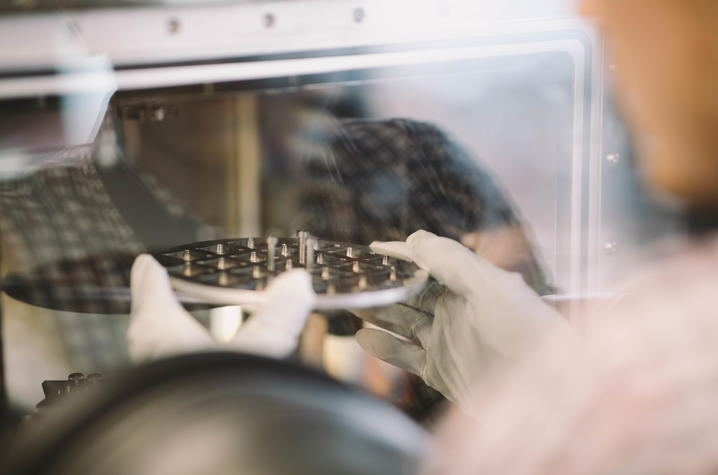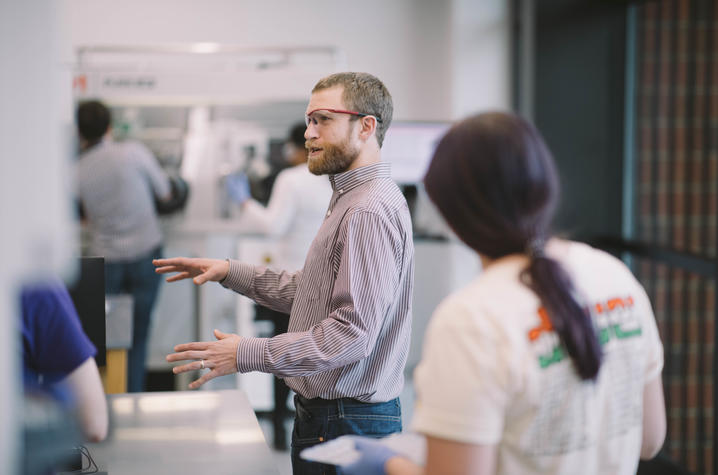Materials Chemistry at UK Has Never Been So 'Fab'
The following article appears in the spring 2019 edition of Ampersand, the UK College of Arts and Sciences magazine. Read more here.
LEXINGTON, Ky. (May 13, 2019) — The "fab" in the University of Kentucky's new "fab lab" may stand for fabrication, but a quick trip inside reveals technology and work that is nothing short of fabulous.
Now in its second semester of operation, the fab lab is a hands-on laboratory extending from the materials chemistry track. The lab is offered as a course for UK chemistry students looking to experience hands-on training in materials chemistry and is one of the only labs of its kind in this field.
Students enrolled in this course can make the jump from simply learning how to make the materials to putting this knowledge into action and creating functioning devices.
"This course is really how to connect material structures and properties to how they actually function in the devices we use today," said Kenneth Graham, assistant professor in the UK College of Arts and Sciences’ Department of Chemistry and contributing teacher and designer of the fab lab course. "It helps students see the actual application of the materials they learn about in their classes."
The fab lab consists of progressive technology for digital fabrication, allowing students to gain practical experience creating materials and models used in modern devices.
"It’s cool being able to see the electronic changes rather than just knowing what’s happening," said David Harris, a chemistry senior enrolled in the fab lab course last semester. "Actually being able to see the electronic changes right in front of you, from the electrochromic where you can watch it change its color and the OLED where you’re actually able to make the light, is just a really awesome aspect of this lab."
As far as creations are concerned, the fab lab creates small-scale models of applicable objects. An example of this is electrochromic devices used in the Boeing 787 Dreamliner and car mirrors that self-dim to deflect bright lights.
"I think the thing that makes this course the most unique is that the students are actually working with materials that are still state-of-the-art. They're not working with materials that people were interested in 20 years ago," Graham said. "They're working with research grade equipment to make functioning devices and to characterize those devices the same way they would be doing if they were working in an industrial or academic research lab."
The creation of the fab lab was no small feat for UK. The rarity of a program and lab like this made its inception particularly special. In the end, a combination of an idea from numerous faculty and fortunate timing of the creation of the new Don and Cathy Jacobs Science Building lent itself to the installation of the fab lab.
"We were lucky that we were thinking of the lab as the Jacobs Science Building was being designed," Graham said. "We had a space that we knew was going to be an instrumental room and we knew that we could easily use that space to make the fab lab."
Beyond being a hands-on and practical option for materials chemistry students, one of the largest benefits of the lab is the relevancy of its course materials. Materials chemistry, like that of the fab lab, makes up almost every valued object in our world, from cell phones to aluminum foil, and topics taught in the fab lab are a basis for almost all of our material belongings.
"If you look around you, almost everything that you see is made by a materials chemist. You've got countertops and paints, or signage and plastics," Graham said. "It's just everywhere. I think the development of technologies is going to make it more relevant because you're going to need better materials, and you're going to need mechanically flexible materials."
With all of these practical applications being offered in the fab lab, this course offers immense long-term benefits for students enrolled. Graduate school, job opportunities, research positions and more are all within grasp for students with this added training.
"Our students will have a leg up for their future goals. They'll have been through a program where they've already made all these standard devices, so they could easily get into a graduate program and hit the ground running," Graham said.
Although it is in its second semester, Graham is confident that the lab will only continue to grow and evolve as long as materials chemistry stays pertinent.
"I don't think it's going anywhere," Graham said. "Materials chemistry has been around for a while and it's going to stay a very relevant area."







